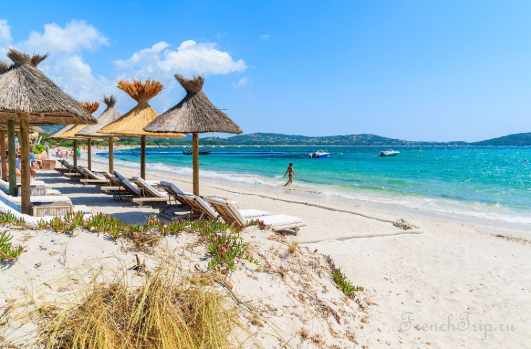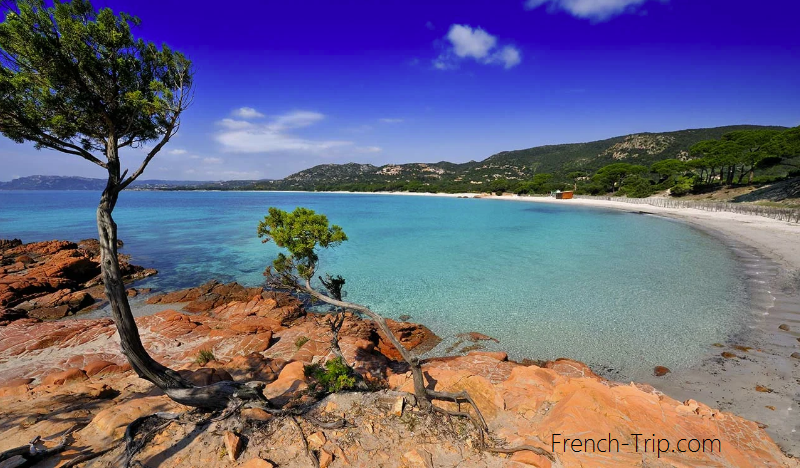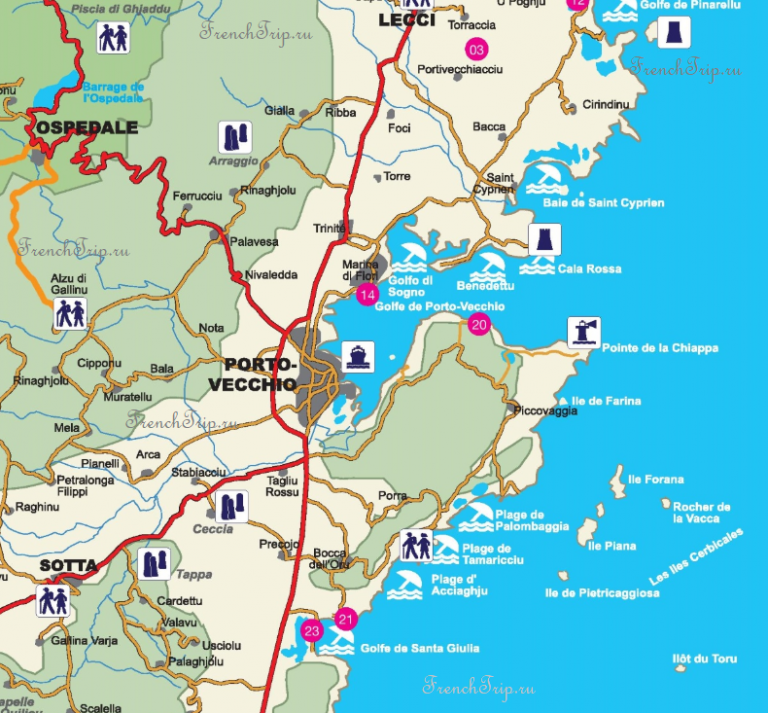Porto-Vecchio
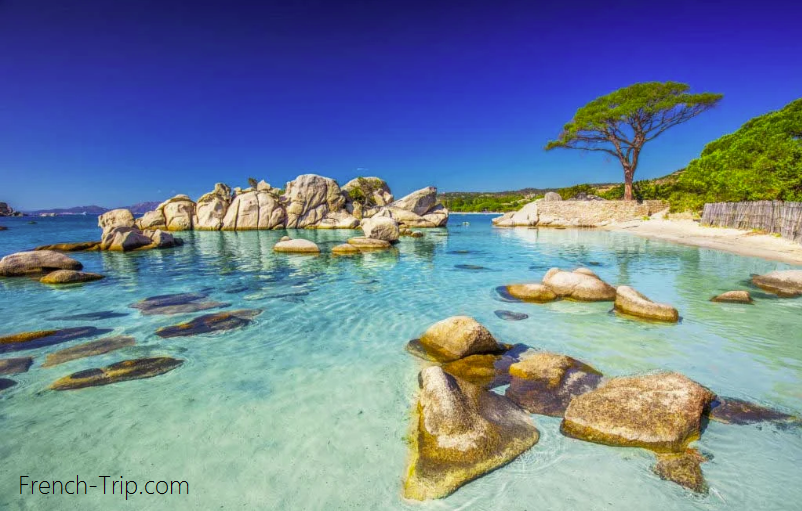
Porto-Vecchio, often referred to as the “City of Salt,” is a charming coastal town located in the southeast of Corsica, about 25 kilometers northeast of Bonifacio and 64 kilometers east of Sartène. Known for its stunning beaches, such as Palombaggia and Santa Giulia, Porto-Vecchio offers crystal-clear turquoise waters and fine white sand, making it one of the top seaside destinations in Corsica. The town itself is rich in history, with its origins as a Genoese fortress, and its picturesque old town still retains cobblestone streets, ancient walls, and charming squares filled with cafes and boutiques.
The coastal part of the city is built on former salt marshes, and salt continues to play an important role in the life of Porto-Vecchio. However, due to the marshes, the region did not develop earlier, as the marshes were infested with mosquitoes and malaria until the 20th century, although the citadel on the hill dates back to the 16th century. In the mid-20th century, the marshes were drained, which, combined with improved communications, allowed the city to develop into a popular seaside resort.
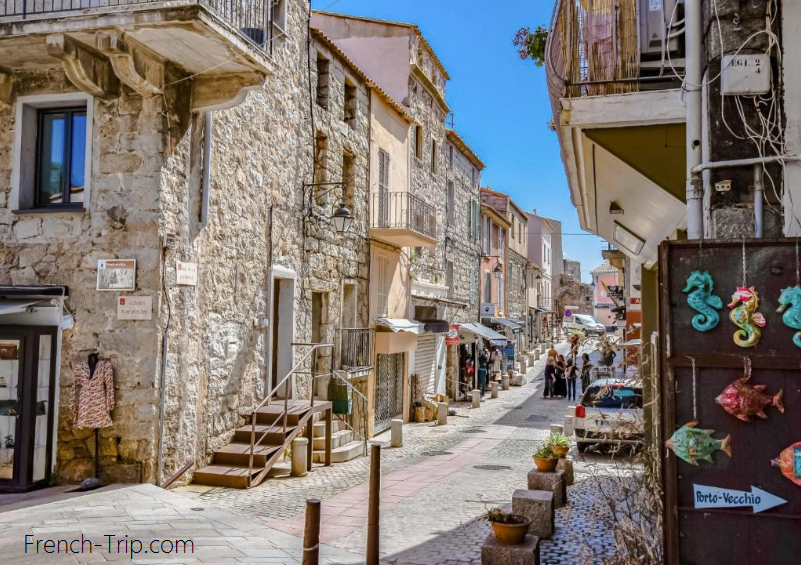
Why visit?
What makes Porto-Vecchio truly special is the blend of its natural beauty with cultural heritage. While the coastal areas are perfect for beachgoers, water sports enthusiasts, and families, the inland areas surrounding the town are home to rugged mountains, pine forests, and scenic hiking trails, such as those in the nearby Ospedale Forest. The town also boasts a lively marina, vibrant nightlife, and fantastic Corsican cuisine.
Good to know
For visitors, it’s important to know that Porto-Vecchio can get busy during the summer months due to its popularity. Booking accommodations and beach access ahead of time is recommended. The town’s proximity to other popular Corsican sites, such as Bonifacio and the Lavezzi Islands, also makes it an ideal base for exploring the southern part of the island.
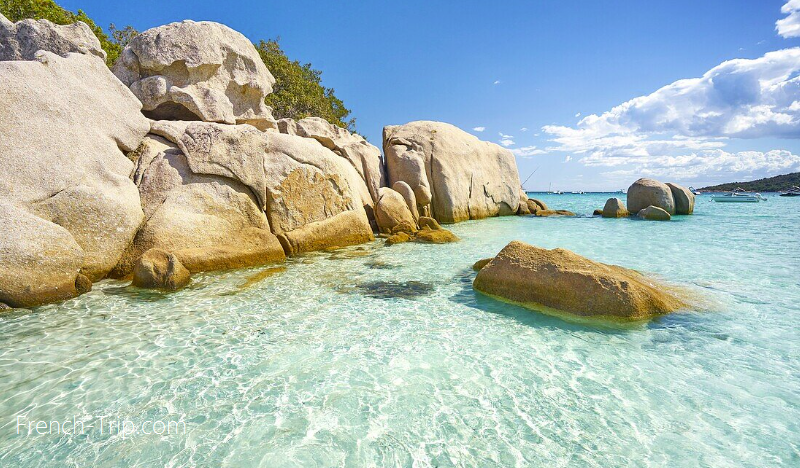
Santa Giulia beach
Get in:
Porto-Vecchio is not directly accessible by train, as there are no train lines in the southern region of Corsica. However, the town is well-connected by buses from major Corsican cities like Ajaccio, Bastia, and Bonifacio. During the high season, shuttle services also operate between Porto-Vecchio and its nearby beaches, making it easier for tourists without cars to visit the stunning coastal spots. Car rental is highly recommended for more flexible and convenient travel around the area.
- Getting Around from Porto-Vecchio: Transport to Beaches, Airports, and Corsican Cities
- Transportation in Corsica
- Trains in Corsica
Public transport to Porto-Vecchio
Public transport: The city used to be served by a narrow-gauge railway from Bastia, with Porto-Vecchio as the terminus. Unfortunately, this line is now closed. So the only way to get here is by hire car or by bus.
There are buses from other major cities in Corsica (Bonifacio, Ajaccio, Bastia, Zonza, Conca, Figari) and ferries from other places. If you are visiting the city in the summer months, it is best to arrive very early, before the 10th (or even the 9th of August), to ensure parking near the city centre. On cloudy or rainy days in August, traffic jams can last up to 2 hours entering or passing through the city.
Nearest airport: Aéroport Figari-Sud Corse, with regular flights from Paris, Marseille and Nice. There are additional flights during the summer season.
Ferry service: direct ferries to Marseille. From nearby Bonifacio there are ferries to Sardinia.
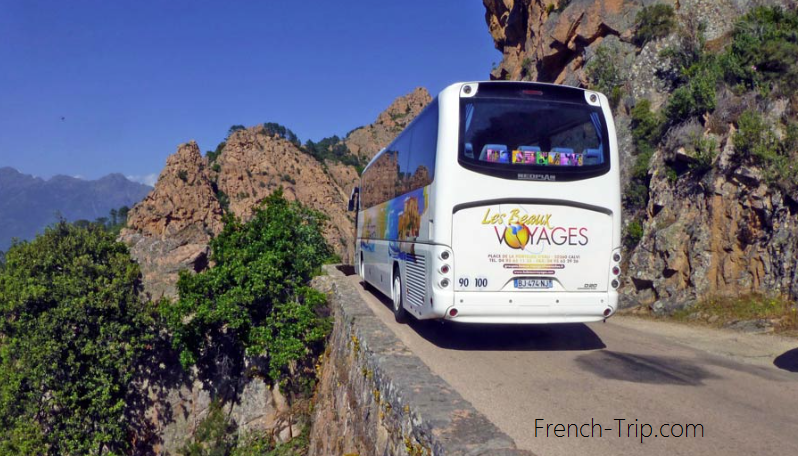
The History of Porto-Vecchio:
Porto-Vecchio is located in a region that was once marshy and severely affected by malaria; however, it was an excellent location for a port. The name means “Old Port,” possibly referring to a Roman port that left traces in the surrounding area. Over time, the region was more or less abandoned due to the malarial swamps but became part of a large Christian parish. The town was re-established in 1539 by the Bank of St. George in Genoa, on a 70-meter hill overlooking the bay.
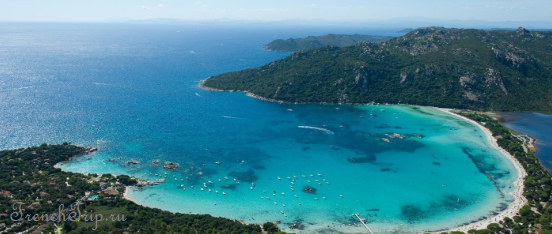
The Genoese sought to preserve the Roman port within walls that have a trapezoidal shape and surround the main square, the Place de la République, near the Church of St. John the Baptist. The Genoese envisioned a colony or population replacement, but malaria soon wiped out most of the Genoese settlers. A second colony in 1546 met the same fate, and the settlement instead became more of a conurbation.
Some of the population began to return with drainage projects initiated during the Second Empire, though they were largely unsuccessful. During World War II, the Allies, determined to eradicate malaria for the health of all involved, particularly soldiers and airmen, took action. Through drainage and spraying, they succeeded in ridding the area of malaria, transforming it into a safe and attractive seaside resort.
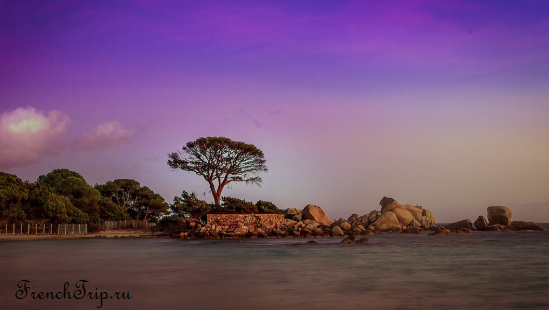
Exploring Porto-Vecchio:
Welcome to Portivechju, one of the must-see cities in the Far South of Corsica. This ancient city, perched on a rocky promontory, overlooks a gulf where the Tyrrhenian Sea rushes in. According to the Ancients, the gulf originally bore the name Portus Syracusanus, a testament to the passage of the Greeks.
As you climb to the terrace of the Bastion de France, one of the historic buildings of Genoese citadel, you’ll begin to understand the city’s immense heritage value. Wherever you cast your gaze, there is something to discover.
The citadel itself stands as a stone monument to the enduring influence of the Genoese, who left their mark here after five centuries of presence. Below lies the old port, Porto Vecchio, where the remnants of a once-thriving industrial past rest quietly. Follow the coastline, and you’ll find the most beautiful beaches in the south opening up before you — white sands, turquoise waters, granite and porphyry rocks, lush scrubland, and pine forests, offering a perfect blend of water sports and relaxation in some of the most idyllic seascapes imaginable.
But there’s more — turn inland, and you’ll find yourself at the foot of U Spidali, a village within the Porto-Vecchio commune, where the highest point, Punta di a Vacca Morta, reaches an altitude of 1,314 meters. With forests, dams, hiking trails, breathtaking panoramas, and a variety of outdoor activities at your fingertips, adventure awaits just beyond the coast!

Main attractions:
Porto-Vecchio offers two main areas to discover: the citadel and old town, along with the marina. Begin your visit at the marina, a quaint spot despite its size, where you’ll find plenty of cafés and restaurants with views of the harbor. It’s a favorite location for evening strolls and an ideal place to unwind on a summer night. From the marina, you can head uphill to explore the citadel.
In the old town, there is a designated route to guide you to the key sights of Porto-Vecchio, though the town center is compact enough that you’ll naturally come across its highlights as you explore. The citadel and narrow streets of the old town date back to the 16th century when Corsica was under Genoese rule.
Although Porto-Vecchio has a lively charm, it’s a relatively small town with few major historical monuments. It’s a lovely spot to soak up the atmosphere, but you can easily see its main attractions in a short time.
Porto-Vecchio Old Town
In Porto-Vecchio’s old town around the Piazza della Repubblica you can discover the original fortifications and ramparts, some fine old buildings squeezed into narrow streets and squares surrounded by picturesque houses. One of the most famous sights in Piazza della Repubblica is a tropical tree called “Bel Ombra“, which was donated to the city in 1901 and has now grown to 10 metres across.
Marina
While strolling along the Porto-Vecchio marina, you can observe the remains of a bygone industrial past: the old cork factories that were the economic flagship of the city, including the St Joseph factory today reinvested by a theater company; the sleeping salt marshes that earned the city the nickname of “City of Salt” and whose production was of inestimable quality. Did you know? The railway from Bastia reached the Quai de la Marine and contributed to the economic effervescence of the port…
Church of San Giovanni Battista
The Church of San Giovanni Battista was built in the 19th century and is quite plain on the outside because funds ran out before the façade was completed. Go inside to see the ornate interior, then return to Piazza della Repubblica to visit one of the cafes at the square.
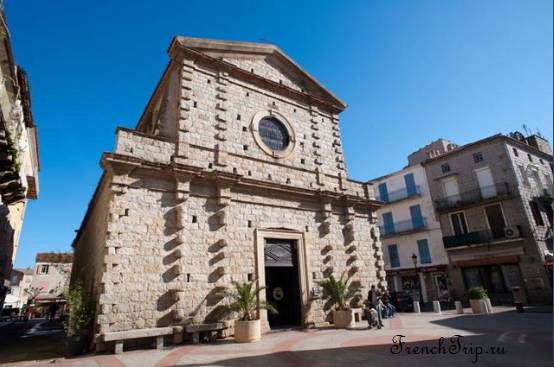
Place Ettori
Another highlight is the picturesque Place Ettori, near the Cours Napoleon. The old house with the grand staircase in this square was once a hospital for Genoese troops.
Bastions
The defensive bastions offer great views, and the old town comes alive with music and entertainment on summer evenings, a good time to enjoy the city at its best. If you visit in September, you can watch the annual salt harvest from the Porte Gènoise, the original entrance to the citadel.
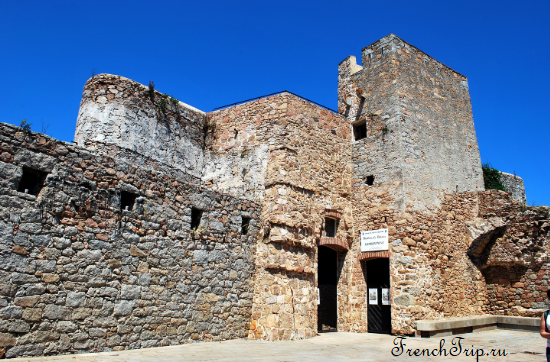
Porto-Vecchio Beaches
First and foremost, it is the beaches and coastline around the town that are the main attraction of Porto-Vecchio, with several stunning beaches in bays along the nearby coastline in both directions. These are typically stunning fine sand beaches with turquoise Mediterranean waters surrounded by extensive pine forests. The beaches to the south of Porto-Vecchio are the most popular with tourists.
Read more:
The beach at Palombaggia, south of Porto-Vecchio, is world-famous as one of the most beautiful beaches in Corsica, with other popular beaches on this stretch of coast including Santa Giulia, a little further south, Tamaricciu and other smaller beaches in between.
Heading north from the town, the most important beaches are Cala Rossa, then Saint-Cyprien and Pinarellu, a little further north. Saint-Cyprien and Palombaggia are popular for families with children.
Porto-Vecchio Map
The city map also shows the beaches, so it will be easier for you to navigate when choosing where to go to relax and sunbathe. Click on the image to enlarge the map.
Around Porto-Vecchio
Boat trips to the Lavezzi Islands leave from the port at Porto-Vecchio or from located nearby Bonifacio.
Porto-Vecchio serves as an excellent base for exploring this region of Corsica. When you’re ready for a break from the beaches and coastal walks, the rugged mountainous landscape behind the town offers breathtaking scenery, with jagged peaks emerging from pine forests around serene mountain lakes. Take the route that passes through L’Ospedale, Zonza, and Col de Bavella to experience some of the area’s most stunning locations.
You’ll also discover numerous charming villages and hamlets tucked away in the mountains. For one of the best coastal views, head to the mountain village of Ospedale, where you can enjoy a peaceful walk by the nearby lakes and perhaps a picnic in the tranquil surroundings.
What to see around Porto-Vecchio
- Figari – one of the oldest vineyards of Corsica, favorite also among windsurfing enthusiasts, as the Gulf of Figari is a popular spot.
Natural sights around Porto-Vecchio
Porto-Vecchio is renowned for its stunning beaches, particularly Palombaggia and Santa Giulia, known for their fine sand and crystal-clear waters. But these breathtaking landscapes are more than just postcard-perfect—they’re protected treasures, preserved by the Bouches de Bonifacio Nature Reserve and the Conservatoire du Littoral.
Did you know that the umbrella pines and Phoenician junipers along Palombaggia Beach play a vital role in preventing erosion by stabilizing the dunes? And those islands you see on the horizon, the Cerbicale Islands, provide a sanctuary for wildlife such as yellow-legged gulls, Cory’s shearwaters, pallid swifts, and tiliguerta lizards, all shielded from human interference.
Santa Giulia Beach, another slice of paradise, hides a rich ecosystem behind its sandy shores. A lagoon, fed by three streams — Lezza, Alzellu, and Vignarellu — is classified as a Natural Area of Ecological, Faunal, and Floristic Interest. This wetland serves as a nursery for species like red-rumped pipits, Cetti’s warblers, and water birds. If you listen carefully in the evening, you might even hear the distinctive croak of the Balearic green toad.
Hiking
For a refreshing escape, head to the Ospedale region. The village, once a resting place for shepherds during their seasonal migration, sits at 948 meters above sea level and offers breathtaking views over the plains and coast. Built from granite, this village marks the gateway to Alta Rocca. Behind it lies a vast forest of lariccio pines and beeches, dotted with gray and pink granite formations streaked with quartz veins. Protected by the National Forestry Office and the Regional Natural Park of Corsica, this area is home to diverse wildlife, including mouflons reclaiming their natural habitat. Endemic species like the Corsican painted frog and the Corsican brook newt also thrive here.
Amidst the forest, a majestic dam awaits discovery, offering a tranquil scene where calm waters mirror the lush mountains, creating a peaceful atmosphere.
For those who love hiking, the trails around Porto-Vecchio provide access to this natural beauty. Walk through the pine forests, visit the Piscia di Ghjaddu waterfall, or follow the Punta di Vacca Morta trail for awe-inspiring views. The trails are well-marked and cater to hikers of all skill levels, from beginners to seasoned adventurers.
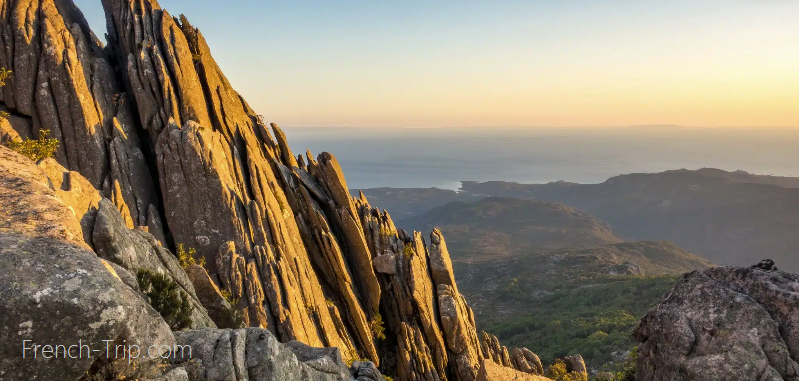
Porto-Vecchio on Corsica’s map:
Archives
Calendar
| M | T | W | T | F | S | S |
|---|---|---|---|---|---|---|
| 1 | 2 | 3 | 4 | |||
| 5 | 6 | 7 | 8 | 9 | 10 | 11 |
| 12 | 13 | 14 | 15 | 16 | 17 | 18 |
| 19 | 20 | 21 | 22 | 23 | 24 | 25 |
| 26 | 27 | 28 | 29 | 30 | 31 | |
